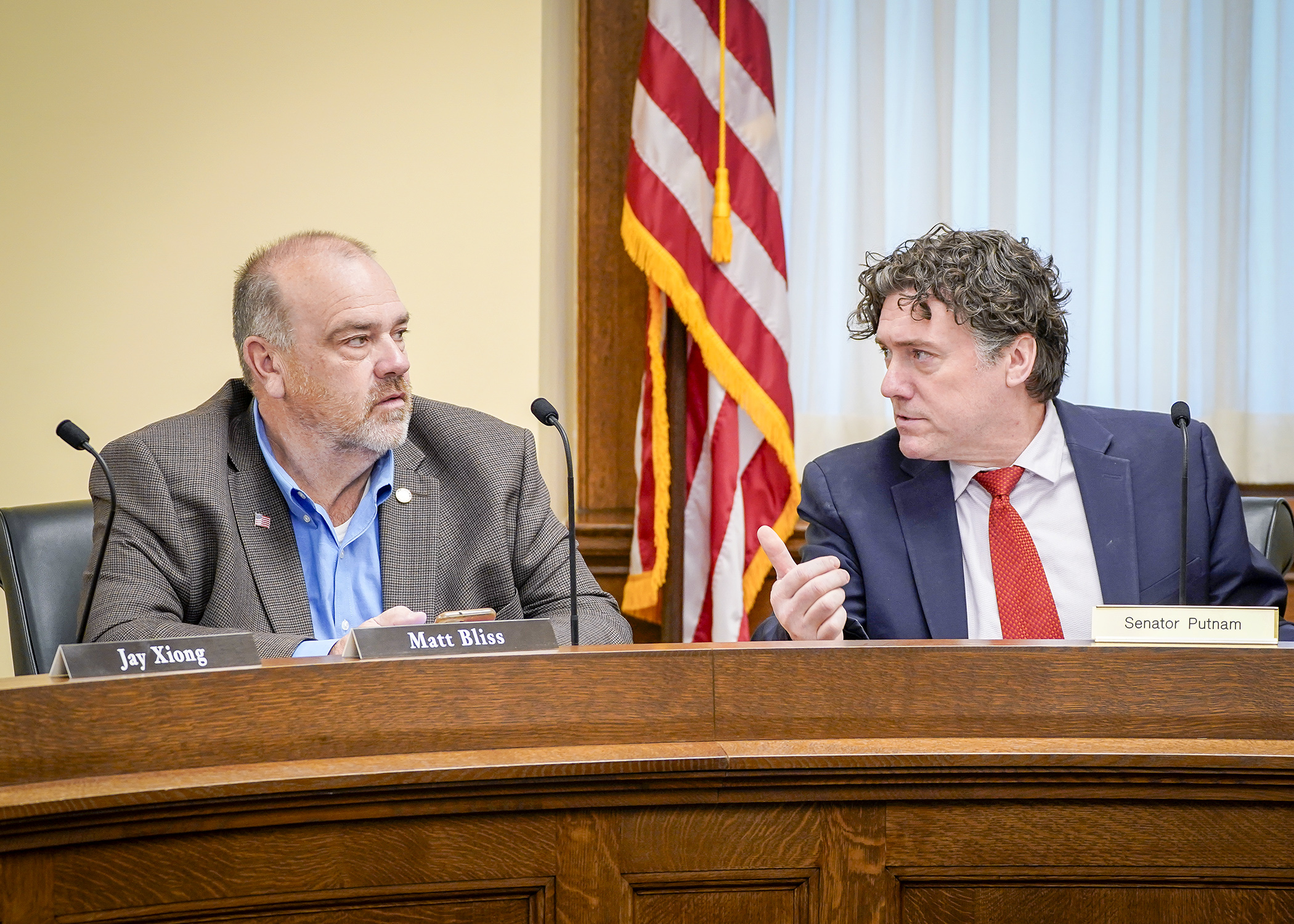Spending gap largest hurdle in reconciling House, Senate versions of veterans bill
Judging by the minimal differences between the House and Senate veterans and military affairs policy and finance bills, reconciliation could be easier than most committees.
That is, once global targets are reached between legislative leaders and the governor.
In keeping with tradition, conferees spent their first get-together Thursday morning reviewing the different versions of HF2444/SF1959*.
Rep. Matt Bliss (R-Pennington) and Sen. Aric Putnam (DFL-St. Cloud) are the respective sponsors.
Spending totals are the largest difference between the two proposals. The Senate checks in at $355.68 million in spending for the 2026-27 biennium, nearly $36 million more than the House.
With its larger spending target the Senate would provide a $39.17 million operating adjustment for the state’s veterans homes. The House has a $11.64 million biennial bump.
 Rep. Matt Bliss and Sen. Aric Putnam chat May 8 before the start of the veterans and military affairs conference committee. (Photo by Andrew VonBank)
Rep. Matt Bliss and Sen. Aric Putnam chat May 8 before the start of the veterans and military affairs conference committee. (Photo by Andrew VonBank)And the House plan would reallocate $10 million from veteran homelessness prevention programs to other areas, including $2.2 million for an increase in suicide prevention programming; $500,000 to increase Metro Meals on Wheels funding for veterans who don’t qualify for other forms of financial assistance; $500,000 for the Lutheran Social Services CORE program to provide home-delivered meals to veterans in Minnesota outside of Hennepin and Ramsey counties and technical, enrollment, outreach, and volunteer recruitment assistance to member programs; and $120,000 for to appoint and train three subject matter experts — women veterans, veteran suicide, and justice-involved veteran technical assistance coordinators — to serve as a resource to county veterans service officers.
[MORE: View detailed spreadsheet, change items]
Both bills call for a $599,000 operating adjustment for the Department of Military Affairs, and the Senate has a $1.19 million operating adjustment — the House has zero — for the Department of Veterans Affairs. Gov. Tim Walz has the Senate numbers in his budget proposal.
Policy
Some minor wording and how-to differences remain, but both bills would:
- grant specified veterans benefits and privileges to certain persons who served with secret guerilla units or other irregular forces in Laos;
- increase the maximum bonded indebtedness allowed for the State Armory Building Commission from $15 million to $45 million;
- update statutes governing veterans burial provisions;
- allow surviving spouses of service members who die because of their military service to remain eligible to use the service member’s education benefits even if the surviving spouse remarries;
- extend the Department of Veterans Affairs’ read-only access to MAXIS, a computer system used to determine eligibility for public assistance; and
- require placement of a memorial plaque in the Court of Honor to recognize the service and sacrifices of Minnesota’s Gold Star and Blue Star families.
[MORE: View policy side-by-side; policy comparison]
As for policy in one body only: the House would add 5% of servicemember base pay as a pension offset for those activated for state active duty, and the Senate would let county veterans service officers assist veterans living in another county if the veteran cannot receive assistance in their home county within two weeks of seeking an appointment.
Related Articles
Search Session Daily
Advanced Search OptionsPriority Dailies
Speaker Emerita Melissa Hortman, husband killed in attack
By HPIS Staff House Speaker Emerita Melissa Hortman (DFL-Brooklyn Park) and her husband, Mark, were fatally shot in their home early Saturday morning.
Gov. Tim Walz announced the news dur...
House Speaker Emerita Melissa Hortman (DFL-Brooklyn Park) and her husband, Mark, were fatally shot in their home early Saturday morning.
Gov. Tim Walz announced the news dur...
Lawmakers deliver budget bills to governor's desk in one-day special session
By Mike Cook About that talk of needing all 21 hours left in a legislative day to complete a special session?
House members were more than up to the challenge Monday. Beginning at 10 a.m...
About that talk of needing all 21 hours left in a legislative day to complete a special session?
House members were more than up to the challenge Monday. Beginning at 10 a.m...